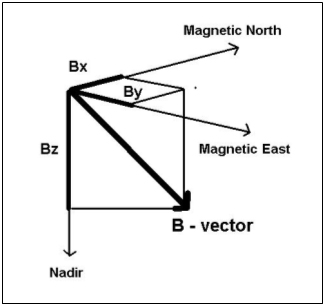Magnetometer data and determining today’s magnetic storminess using a single number
Background Information
Modern ‘Magnetic Observatories’ use instruments called magnetometers to measure the three components of Earth’s magnetic field at ground level. The three-component plots are easier to understand if we remember that many physical quantities are plotted according to the magnitude of a quantity and the time of the measurement. Temperature is a physical quantity that is defined by a single number at each point in space. We only need one graph to plot how a temperature changes in time. There are other physical quantities that can also be described by a single number, for instance, density, mass, color and brightness. Notice that magnetism is not one of these!
Because magnetism is a physical quantities defined by BOTH a magnitude and a direction, it requiresa bit more work to describe fully, unlike temperature. Because the direction can be anywhere in 3-dimensional space, we have to define magnetism by its direction along three axis perpendicular to each other. Just as ‘velocity’ measures both the speed and direction of a body in motion, the magnetic field is a similar ‘vector’ quantity that has to be defined both by its strength and its direction. We need three plots to determine how magnetism changes in time, each plot representing a direction.
The units we use to measure magnetic strength is the Tesla. A Tesla is a unit of magnetic flux density. Earth’s magnetic field is small compared to a Tesla: 50 million times smaller (50 ‘micro-Tesla’ or ‘µT’). The magnetic field changes on Earth’s surface due to space weather is even smaller and are more conveniently defined by the ‘nanoTesla’ or nT, which is one billion times smaller than a Tesla. Earth’s surface magnetic field is approximately 50,000 nT.
 |
The figure to the left shows the relationship between the direction that a magnetic field is pointing and its magnitude in a Cartesian coordinate system. The origin of the coordinate system is the physical point in space where the field is being measured. You can think of this as the place where your magnetometer is buried. The thick line connected to the Origin represents the magnetic field vector. Its length represents the magnitude of the magnetic field. |
To describe its direction, the THEMIS, GEONS magnetometers are lined up so that they measure that the coordinate system is such that:
- X: represents the magnetic field strength in roughly the direction of the north magnetic pole. A positive x-value means that part of the magnetic field is pointing north. A negative x-value means that part of the magnetic field is pointing south.
- Y: represents the magnetic field strength 90 degrees from the x-direction in the “magnetic east” direction. A positive y-value means that part of the magnetic field is pointing towards magnetic east. A negative y-value means that part of the magnetic field is pointing towards magnetic west.
- Z: represents the magnetic field strength in the local nadir direction (vertically down).
Kp is a relative strength of a magnetic storm in Earth’s magnetic field (magnetosphere). It is determined by the global averages of a large number of magnetometers that are scattered around the North American Continent and Europe. The Kp index is determined by averaging over all of the measured K indices on a 3-hour or shorter interval. The K index is determined by the average of the A index and then is converted by a table of comparison. The A index is the difference between the maximum and minimum reading for the X component of the magnetometer.
This activity is not designed to replace the actual Kp index but you to take readings from a magnetometer and make a Kp index estimate. Using this estimate you can make a prediction as to whether an aurora display will occur that night.
The A index is determined by the maximum strength of the X component minus the minimum strength of the X component for a three hour time period (X max - X min). For our Activity we will determine the Max-Min strength for a 24-hour time period. Thus, in a sense, your reading will be similar to an A index average. Using the following table we can convert the A index component strength difference directly to a K index.
Note that if there are spikes in the data, then this could be due to human-caused magnetometer signatures. Please check other magnetometers to see if the spike exists. If it does not exist at the exact same Universal Time, then it should not be counted as a maximum or minimum.
Procedure
Finding the A index
- Print off today’s XYZ data from a 24-hour plot from the THEMIS magnetometers in schools around the U.S. or near you.
- Using a clear metric ruler 15 mm length, align the start of the ruler with the left side of the X scale.
- Using a sharp pencil select the highest reading of the X component and draw a line to the X component scale. Please see “Note” above.
- Repeat 3 except draw a line on the X component minimum reading. Please see “Note” above.
- Using the metric ruler measure the difference in mm
- Convert your different in mm to nT and write down your value in the worksheet table.
Converting the A index to the K index
- Find the difference and compare it to the conversion table to obtain an approximate K index value. This is the strength of the magnetic storm on the magnetometer you have chosen.
- By comparing this information to the Kp index (http://www.sec.noaa.gov/rt_plots/kp_3d.html) you may be able to predict the possibility of an Aurora display that night near the magnetometer.
